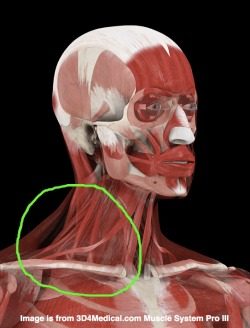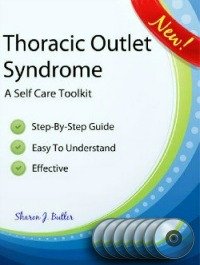Thoracic Outlet Syndrome Symptoms
Thoracic Outlet Syndrome symptoms most often include numbness, tingling and reduced blood flow in the arms and hands. These symptoms are caused by adhesions in the muscles in the neck and upper chest which interfere with the normal signals coming from the brachial plexus bundle of nerves that serve the arms and hands.
Thoracic Outlet Syndrome Symptoms Result From Compression Of The Brachial Plexus Nerve Bundle

Thoracic Outlet Syndrome symptoms are generally caused by compression of the soft tissues at the side of the neck. Passing through this area is a major nerve bundle known as the Brachial Plexus, which sends sensation to the entire arm. In Thoracic Outlet Syndrome, the brachial plexus becomes pinched or restricted.
Also passing through the same area at the side of the neck are several major blood vessels. Compression of these blood vessels can also contribute to troubling symptoms, making it feel like circulation has been cut off.
• Thoracic Outlet Syndrome Causes Numbness
TOS symptoms include numbness of the entire arm and hand due to compression of the brachial plexus as it passes through the neck and shoulder regions of the body.
As the nerve bundle crosses the front of the upper chest, the nerve and its fascial sheath can become stuck to the pectoralis minor muscle. Pain and numbness can be constant or intermittent, and are often determined by the posture of the body.
An unconscious habit that often contributes to the shifts in anatomy that can lead to Thoracic Outlet Syndrome is raising the shoulders. This can become an unconscious habit by always carrying a bag, purse or child on the same side of the body. It can even happen if you always prop the same arm on the arm of a sofa as you watch TV!
Try the Tape Trick to become aware of when you are unconsciously raising your shoulders.
If only some parts of the hand and arm are numb, then other conditions such as Carpal Tunnel Syndrome, Ulnar Tunnel Syndrome (also known as Cubital Tunnel Syndrome), or Radial Tunnel Syndrome should be considered.

Click HERE to Learn More
• Aching
Deep ache or pain in the arms or shoulders is also characteristic of Thoracic Outlet Syndrome. Aches or pains may be constant, or may occur only when moving parts of the upper body, or holding those body parts in certain positions.
• Loss of Circulation
Since compression of major blood vessels can also be present in Thoracic Outlet Syndrome, symptoms can also include loss of circulation in the arm and hand.
In some cases, the hands or fingers will turn blue or white in color, or they will get cold due to restricted circulation.
Circulation is often cut off or affected when the arm is placed over the head, or forward of the body, squeezing the space that the blood vessels pass through.
• Disturbed Sleep Patterns
Sleep patterns are often disturbed in many cases of Thoracic Outlet Syndrome. Sleeping can bring on increased symptoms due to the compression of the nerve plexus or blood vessels when lying down. Mattresses that are too soft or too firm can also contribute to problems because they force the body out of its proper alignment when in a lying position.
The same thing applies to pillows! It's important to find a pillow that fills the gap between the body and the bed without pushing the neck and head out of their proper alignment.
• Structural Stress
Shortened neck muscles can lead to compression of the neck vertebrae. This tends to make it more difficult to turn or tilt the head.
To compensate, many people begin raising their shoulders to create some slack in the tight and restricted scalene muscles found at the side of the neck. Unfortunately, lifting the shoulders can, over time, create its own set of complex, painful and bewildering symptoms and should be avoided.
• Restricted Breathing
Restricted breathing may also be a troubling symptom. As the scalene muscles shorten, they are strong enough to raise the position of the first rib, which they are attached to. The lung is attached to the underside of the first rib. So, when the rib is lifted, it puts strain on the fascia covering the lung, making it more difficult to fill the upper portion of the lung with air. A feeling of restricted lung capacity can be the result.
The symptoms of Thoracic Outlet Syndrome are complex and often bewildering because they can be the result of a combination of things all affecting the body in different ways.
To learn more about Thoracic Outlet Syndrome, visit these sections to familiarize yourself as much as possible with this complex condition.
How To Recover From Thoracic Outlet Syndrome
Thoracic Outlet Syndrome Anatomy
Thoracic Outlet Syndrome Self Care
Click the block below that most closely matches your injury for more information and to find the Toolkit we offer to help you in your recovery.







